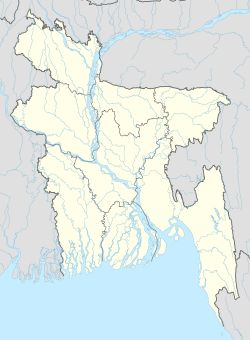world.wikisort.org - Bangladesh
Akhaura (Bengali: আখাউড়া) is an upazila of Brahmanbaria District, a district under Chattogram, Bangladesh. Akhaura Upazila has an area of 99.28 km2. The main river that run through this upazila is the Titas River. Akhaura played an important historical role during both World War II and Liberation War of Bangladesh.[citation needed]


This article needs additional citations for verification. (January 2016) |
Akhaura
আখাউড়া | |
|---|---|
Upazila | |
 Akhaura Railway Station | |
 Akhaura Location in Bangladesh | |
| Coordinates: 23°52′05″N 91°12′30″E | |
| Country | |
| Division | Chattogram Division |
| District | Brahmanbaria District |
| Government | |
| • Municipal Mayor | Takjil Khalifa Kajal |
| • Upazila Chairman | Kashem Vhuiyan |
| Area | |
| • Upazila | 98.04 km2 (37.85 sq mi) |
| • Urban | 8.22 km2 (3.17 sq mi) |
| Population (2011)[1] | |
| • Upazila | 145,215 |
| • Density | 1,500/km2 (3,800/sq mi) |
| • Urban | 36,262 |
| Time zone | UTC+6 (BST) |
| Postal Code | 3450 |
| Website | akhaura |
The administration of Akhaura thana, now an upazila, was established in 1976. The upazila includes one municipality, five union parishads, 107 mouzas and 113 villages.[2]
History

During the Indo-Pakistani War of 1971 for the liberation of Bangladesh, Pakistan Army planners predicted India would launch its main attack in the east along the Akhaura–Brahmanbaria axis; however, the army had no troops in this area, so the 27th brigade at Mymensingh was moved to Akhaura, except for two battalions (which became the 93rd brigade) that were retained for the defence of Mymensingh.[3] Pakistan Army's 93,000 troops unconditionally surrendered to the Indian Army and India's local ally Mukti Bahini on 16 December 1971.[4] This day and event is commemorated as the Bijoy Dibos (Bengali: বিজয় দিবস) in Bangladesh and Vijay Diwas in India.[5][4]
Demographics
As of the 2011 Bangladesh Census, there were 145,215 inhabitants across 27,831 households in Akhaura Upazila. There were 93 males (48.3%) to every 100 females (51.7%). Children (0-14) made up 40.7% of the population. The vast majority of the population were adherents of Islam (94.2%), with 5.8% being adherents of Hinduism. The average literacy rate was 52.8% for those aged 7 and above, compared to a national average of 47.1%.[1][6]
Points of interest
- Kharampur Mazar Sharif, the mausoleum of Hazrat Syed Ahmad Gesudaraz (R), is a pilgrimage site for devotees.[2]
Administration
Akhaura Upazila is divided into Akhaura Municipality and five union parishads: Dakshin Akhaura, Dharkhar, Monionda, Mogra, and Uttar Akhaura. The union parishads are subdivided into 86 mauzas and 112 villages.[7]
Akhaura Municipality is subdivided into 9 wards and 23 mahallas.[7]
Transport


Plans are underway to have Akhaura connected to Agartala, India via railway by 2017.[8][9]
In 2013–14, Bangladesh exported TK 2.26 billion through the Akhaura Land Port to India.[10]
Education

There are several schools and colleges in Akhaura. As in 2016, there is no university in Akhaura upazila. According to Banglapedia, Bangladesh Railway Government High School, founded in 1920, is a notable secondary school.[2]
See also
- Upazilas of Bangladesh
- Districts of Bangladesh
- Divisions of Bangladesh
References
- "Population and Housing Census 2011: Zila Report: Brahmanbaria" (PDF). Bangladesh Bureau of Statistics. October 2015. Retrieved 8 June 2018.
- Udin, Mohammad Mofiz (2012). "Akhaura Upazila". In Islam, Sirajul; Jamal, Ahmed A. (eds.). Banglapedia: National Encyclopedia of Bangladesh (Second ed.). Asiatic Society of Bangladesh.
- Salik, Siddiq, Witness to Surrender, pp126
- Team, Editorial (17 December 2017). "Why Do India Celebrate 'Vijay Diwas' On 16th December". SSBToSuccess. Retrieved 18 December 2017.
- "About us". Liberation War Museum. Archived from the original on 8 November 2011. Retrieved 21 November 2011.
- "District Statistics 2011: Brahmanbaria" (PDF). Bangladesh Bureau of Statistics. pp. 16–17. Archived from the original (PDF) on 28 January 2016.
- "District Statistics 2011: Brahmanbaria" (PDF). Bangladesh Bureau of Statistics. Archived from the original (PDF) on 13 November 2014. Retrieved 14 July 2014.
- "Agartala-Akhaura railway link to connect India and Bangladesh; will be completed by 2017 - The Economic Times".
- "India approves new railway link with Bangladesh". TwoCircles.net. 21 September 2011.
- "No export, import at Akhaura port on July 25, 26". bdnews24.com. 24 July 2015. Retrieved 7 August 2020.
На других языках
- [en] Akhaura Upazila
[ru] Акхаура
Акхаура (бенг. আখাউড়া, англ. Akhaura) — город и муниципалитет на востоке Бангладеш, административный центр одноимённого подокруга. Площадь города равна 2,35 км². По данным переписи 2001 года, в городе проживало 32 435 человек, из которых мужчины составляли 50,43 %, женщины — соответственно 49,57 %. Уровень грамотности населения составлял 51,5 % (при среднем по Бангладеш показателе 43,1 %). Акхаура является крупным железнодорожным узлом Бангладеш.Другой контент может иметь иную лицензию. Перед использованием материалов сайта WikiSort.org внимательно изучите правила лицензирования конкретных элементов наполнения сайта.
WikiSort.org - проект по пересортировке и дополнению контента Википедии